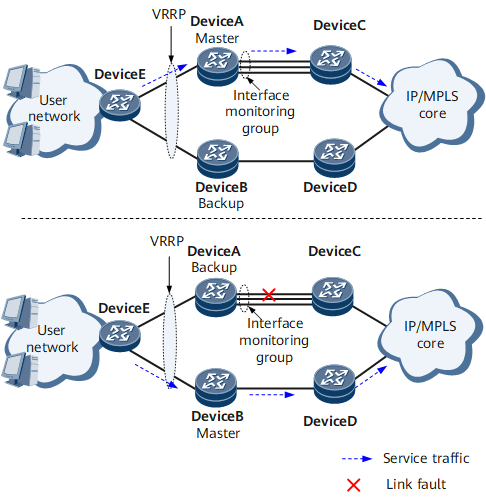VRRP Tracking an Interface Monitoring Group
Background
To prevent failures on a VRRP-disabled interface from causing service interruptions, configure a VRRP group to track the VRRP-disabled interface. However, a VRRP group can track only one VRRP-disabled interface at a time. As the network scale is expanding and more interfaces are appearing, a VRRP group is required to track more VRRP-disabled interfaces. If the original technology is used, the configuration workload is very large.
To reduce the configuration workload, you can add multiple VRRP-disabled interfaces to an interface monitoring group and enable a VRRP group to track the interface monitoring group. When the link failure ratio of the interface monitoring group reaches a specified threshold, the VRRP group performs a master/backup switchover to ensure reliable service transmission.
Related Concepts
- A VRRP group can track two interface monitoring groups on the access side in normal mode (link is not specified). When the link failure ratio on the access side reaches a specified threshold, the VRRP group reduces the priority of the local device to trigger the remote device to preempt the Master state.
- A VRRP group can track one interface monitoring group on the network side in link mode. When the link failure ratio on the network side reaches a specified threshold, the local device in the VRRP group changes to the Initialize state and sends a VRRP Advertisement packet carrying a priority of 0 to the remote device to trigger the remote device to preempt the Master state.
Implementation
Each interface in an interface monitoring group has a Down weight. If an interface goes Down, the fault weight of the interface monitoring group to which the interface belongs increases; if an interface goes Up, the fault weight of the interface monitoring group to which the interface belongs decreases. The fault weight of an interface monitoring group reflects link quality. VRRP can be configured to track an interface monitoring group. If the fault weight of the interface monitoring group changes, the system notifies the VRRP module of the change. The VRRP module calculates the VRRP priority or status based on the fault rate of the interface monitoring group, configured monitoring mode, and priority change value.

Benefits
Configuring VRRP to track an interface monitoring group on a device where a VRRP group is configured helps to reduce the workload for configuring the VRRP group to track VRRP-disabled interfaces.